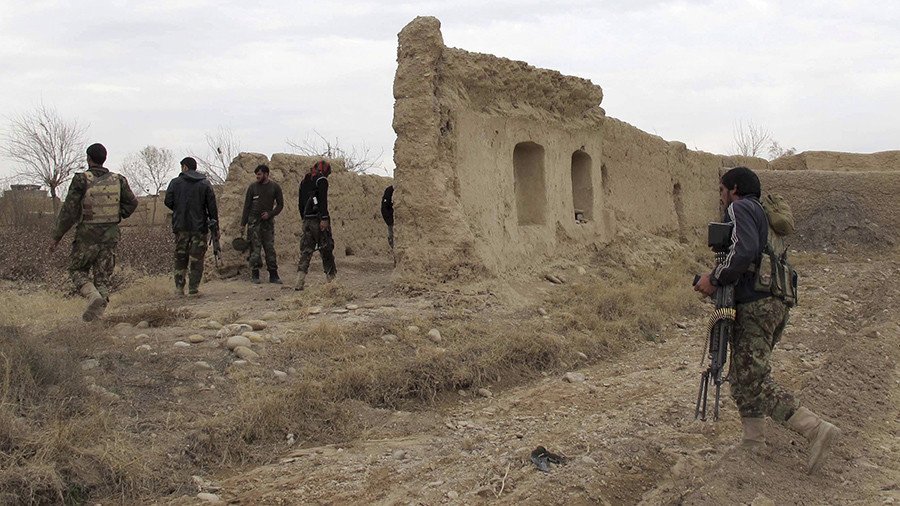Amen corner? Top US Army general says Afghan war has ‘turned a corner’

The top US and NATO commander in Afghanistan says the war has “turned a corner,” a claim made verbatim dozens of times over the conflict’s 16 years. However, this new military strategy has apparently been a real “game changer.”
On Tuesday, US Army General John Nicholson, commander of the US and NATO mission in Afghanistan, told reporters that the “Taliban cannot win” under a new US strategy in the area. However, it is not the first time that US officials have made similar proclamations.
During a video briefing at the Pentagon, Nicholson said that 2018 would be a different year for US-led coalition forces in the country.
One hundred days after President Donald Trump announced his South Asia strategy, Nicholson said that the new plan has been a “game changer,” which has helped put the Afghan government forces “on a path to a win.”
“We can see the impacts already, especially in terms of our adversary's reactions,” Nicholson said.
Nicholson said that there have been two changes to the enemy’s strategies that indicate “a lowering of ambition by the enemy.” First, Nicholson said that the Taliban has shifted from taking capitals to a district-focused strategy. Then, he said they shifted to guerrilla-style warfare, not to gain and control territory, but to be “relevant.”
Trump’s strategy involves sending 3,000 new US troops to the region and giving coalition forces increased authority to drop more than three times the number of bombs.
Nicholson said that one of the most important changes came after Afghan President Ashraf Ghani fired five of his six corps commanders and named a new chief of general staff and defense minister.
“The Afghan commanders that make up that core have never lost a battle against the Taliban and they never will. They are the most feared and respected force in Afghanistan today and they’re the best special operations force in the region,” Nicholson said.
Looking ahead to 2018, Nicholson said that US and Afghan forces have “turned the corner” and “the momentum is now with the Afghan security forces.”
The statement come a week after Nicholson told NBC News that the war in Afghanistan remained in a “stalemate,” but said that he had confidence in President Donald Trump’s new strategy in the region.
“We are only 90 days into this new policy, but with the US forces that will be arriving, with the new authority that we have been given, put the pressure on external enablers, with the fact that we are condition based and not time based, we've set all the conditions to win,” Nicholson told NBC News.
However, US officials have used similar phrases to describe the situation in Afghanistan several times in the 16 years since the war began.
Obama, 2011: We have ‘turned the corner’ in fight against TalibanPanetta, 2012: we have ‘turned the corner’ in fight against TalibanGen. Nicholson, 2017: we have ‘turned the corner’ in fight against Taliban https://t.co/tUg0ojTz3G
— Robbie Gramer (@RobbieGramer) November 28, 2017
2013
In January 2013, former Afghan President Hamid Karzai said that Afghan forces had turned the corner in their fight against the Taliban. He predicted that Islamic extremists would not be able to gain a foothold in the country to enforce their religious agenda.
“I think there is now a critical mass in Afghanistan of the educated, of the Afghan people who want a future of progress and stability. And I think, also, that the Taliban have recognized that the corner has been turned,” Karzai said, according to CNN.
2012
In September 2012, former US Defense Secretary Leon Panetta said that coalition forces had turned the corner after former President Barack Obama ordered a “surge” of 33,000 US troops to leave the country in the hands of Afghan security forces.
“The surge did accomplish it objectives of reversing the Taliban momentum on the battlefield and dramatically increasing the size and capability of the Afghan national security forces,” Panetta said, according to the New York Post.
2011
In June 2011, Obama told soldiers at Fort Drum in upstate New York that his strategy led to a turning point that would allow the surge in US troops to return home after training Afghan soldiers.
“Last night, I gave a speech in which I said that we have turned a corner where we can begin to bring back some of our troops,” Obama said, according to White House archives. “But because of your outstanding work, what we’ve been able to do is train an additional 100,000 Afghan soldiers so that they can start carrying on the fight.”
US soldier killed during operation in eastern Afghanistan https://t.co/6fCscrmt60pic.twitter.com/p6kPw6QBYN
— RT America (@RT_America) November 4, 2017
2010
In February 2010, Army General Stanley McChrystal, the former top US commander in Afghanistan, said he believed Helmand Province had “turned the corner.”
“I am not prepared to make pronouncement on the country but they have clearly turned the corner here,” McChrystal told the Telegraph. “If we make it durable then I think it will become contagious.”
Since then, Helmand has become one of the deadliest provinces in the country, with one Afghan General Wali Mohammad Ahmadzai telling NPR earlier this month that the area is “the mother of problems for the country.”
READ MORE: US prepared to stay in Afghanistan indefinitely – Pentagon chiefs
However, as recent as June 2017, Secretary of Defense James Mattis told the Senate Armed Services Committee that coalition forces “are not winning in Afghanistan right now.”













